
RMS Olympic was a British ocean liner and the lead ship of the White Star Line's trio of Olympic-class liners. Unlike the other ships in the class, Olympic had a long career spanning 24 years from 1911 to 1935. This included service as a troopship during the First World War, which gained her the nickname "Old Reliable". She returned to civilian service after the war, and served successfully as an ocean liner throughout the 1920s and into the first half of the 1930s, although increased competition, and the slump in trade during the Great Depression after 1930, made her operation increasingly unprofitable.

The RMS Queen Mary is a retired British ocean liner that sailed primarily on the North Atlantic Ocean from 1936 to 1967 for the Cunard Line and built by John Brown & Company in Clydebank, Scotland. Queen Mary, along with RMS Queen Elizabeth, were built as part of Cunard's planned two-ship weekly express service between Southampton, Cherbourg and New York. The two ships were a British response to the express superliners built by German, Italian and French companies in the late 1920s and early 1930s.

RMS Lusitania was a British ocean liner that was sunk on 7 May 1915 by a German U-boat 11 miles (18 km) off the southern coast of Ireland, killing 1,198 passengers and crew. The sinking presaged the United States declaration of war on Germany. Although the Lusitania sinking was a major factor in building support for a war, a declaration of war did not take place until nearly two years later, after repeated other attacks and German use of unrestricted warfare against American shipping.
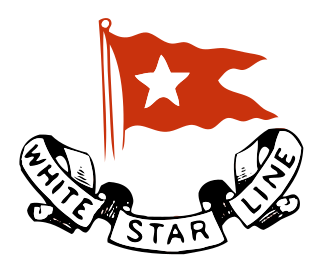
The Oceanic Steam Navigation Company, more commonly known as the White Star Line (WSL), was a British shipping company. Founded out of the remains of a defunct packet company, it gradually rose up as one of the most prominent shipping lines in the world, providing passenger and cargo services between the British Empire and the United States. While many other shipping lines focused primarily on speed, White Star branded their services by focusing more on providing steady and comfortable passages, for both upper class travellers and immigrants. Today, it is most famous for the innovative vessel Oceanic of 1870, and for the losses of some of their best passenger liners, including the wrecking of RMS Atlantic at Halifax in 1873, the sinking of RMS Republic off Nantucket in 1909, the loss of RMS Titanic in 1912 and HMHS Britannic in 1916 while serving as a hospital ship. Despite its casualties, the company retained a prominent hold on shipping markets around the globe before falling into decline during the Great Depression, which ultimately led to a merger with its chief rival, Cunard Line, which operated as Cunard-White Star Line until 1950. Cunard Line then operated as a separate entity until 2005 and is now part of Carnival Corporation & plc. As a lasting reminder of the White Star Line, modern Cunard ships use the term White Star Service to describe the level of customer care expected of the company.

Thomas Andrews Jr. was a British businessman and shipbuilder. He was managing director and head of the drafting department of the shipbuilding company Harland and Wolff in Belfast, Ireland.

The sinking of the RMS Titanic in 1912 shocked the world, and attracted so much controversy that a number of conspiracy theories have been put forward regarding the disaster.

The SS Manhattan was a 24,189-ton luxury liner of the United States Lines, named after the borough of New York City. On 15 June 1941, the Manhattan was commissioned as the USS Wakefield and became the largest vessel ever operated by the US Coast Guard. In 1942, the ship caught fire and was rebuilt as a troop ship. The Manhattan never saw commercial service again.

The set of large ornate staircases in the first-class section of the RMS Titanic, sometimes collectively referred to as the Grand Staircase, is one of the most recognizable features of the British transatlantic ocean liner which sank on her maiden voyage in 1912 after a collision with an iceberg. Reflecting and reinforcing the staircase's iconic status is its frequent, and prominent, portrayal in media.

SS Servia, also known as RMS Servia, was a successful transatlantic passenger and mail steamer of revolutionary design, built by J & G Thomson of Clydebank and launched in 1881. She was the first large ocean liner to be built of steel instead of iron, and the first Cunard ship to have an electric lighting installation. For these and other reasons, maritime historians often consider Servia to be the first "modern" ocean liner.

RMS Campania was a British ocean liner owned by the Cunard Steamship Line Shipping Company, built by Fairfield Shipbuilding and Engineering Company of Govan, Scotland, and launched on Thursday, 8 September 1892.

The Olympic-class ocean liners were a trio of British ocean liners built by the Harland & Wolff shipyard for the White Star Line during the early 20th century. They were Olympic (1911), Titanic (1912), and Britannic (1915). All three were designed to be the largest and most luxurious passenger ships in the world, designed to give White Star an advantage in the transatlantic passenger trade.

SS Otway was a British ocean liner owned by the Orient Line, built by Fairfield Shipbuilding and Engineering Company of Glasgow, Scotland, launched in 1908 and completed in 1909.
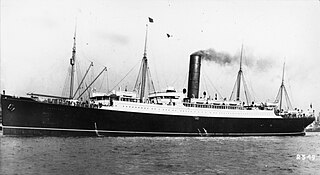
The RMS Carpathia was a Cunard Line transatlantic passenger steamship built by Swan Hunter & Wigham Richardson in their shipyard in Newcastle upon Tyne, England.

USS Lydonia (SP-700) was United States Navy patrol vessel in commission from 1917 to 1919 that saw service during World War I. Prior to her U.S. Navy service, she had been William A. Lydon's private yacht, Lydonia II, from 1912 to 1917. She spent most of the war based at Gibraltar, escorting and protecting Allied ships in the Mediterranean and along the Atlantic Ocean coast of Europe. After her U.S. Navy service ended, she served from 1919 to 1947 in the United States Coast and Geodetic Survey as the coastal survey ship USCGS Lydonia (CS-302).
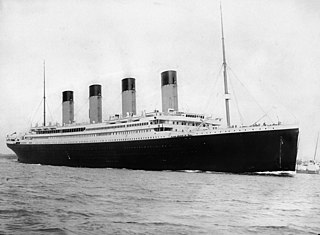
RMS Titanic was a British passenger liner operated by the White Star Line that sank in the North Atlantic Ocean in the early morning hours of 15 April 1912, after striking an iceberg during her maiden voyage from Southampton to New York City. Of the estimated 2,224 passengers and crew aboard, more than 1,500 died, making the sinking one of modern history's deadliest peacetime commercial marine disasters. RMS Titanic was the largest ship afloat at the time she entered service and was the second of three Olympic-class ocean liners operated by the White Star Line. She was built by the Harland and Wolff shipyard in Belfast. Thomas Andrews, chief naval architect of the shipyard at the time, died in the disaster.

SS Stella Solaris was an ocean liner built for Messageries Maritimes in 1952. She mainly provided passenger service between France, the Middle East, Southeast Asia, and Japan.
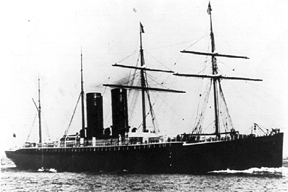
SS Oregon was a record breaking British passenger liner that won the Blue Riband for the Guion Line as the fastest liner on the Atlantic in 1884. She was sold to the Cunard Line after a few voyages and continued to improve her passage times for her new owner. In 1885, Oregon was chartered to the Royal Navy as an auxiliary cruiser, and her success in this role resulted in the Admiralty subsidizing suitable ships for quick conversion in the event of a crisis. She returned to Cunard service in November 1885 and four months later collided with a schooner while approaching New York. All persons on board were rescued before Oregon sank. Her wreck, 18 miles east of Long Island, remains a popular diving site.

SS Monroe was an Old Dominion Steamship Company steamship launched 18 October 1902 and completed 3 April 1903 by Newport News Shipbuilding of Norfolk, Virginia for operation in the company's Old Dominion Line's "Main Line Division" for overnight service between New York and Norfolk and could make 16 knots (30 km/h). The ship had accommodations for 150 first class, 78 steerage and 53 deck passengers. That service was between New York pier 26, North River, and Norfolk connecting with the line's "Virginia Division" steamers, including Old Dominion's "Night Line Steamers" Berkley and Brandon serving Richmond with overnight service to Norfolk, other steamer lines and rail lines serving the Chesapeake Bay area. The Monroe was struck at about 2 a.m. on 30 January 1914 by the southbound steamer Nantucket and sank with loss of forty-one lives.

TSS (RMS) Mona's Queen (III) No. 145308, was a ship built for the Isle of Man Steam Packet Company in 1934. The steamer, which was the third vessel in the company's history to bear the name, was one of five ships to be specially commissioned by the company between 1927 and 1937. They were replacements for the various second-hand steamers that had been purchased to replace the company's losses during the First World War. However, the life of the Mona's Queen proved to be short: six years after being launched she was sunk by a sea mine during the Dunkirk evacuation on 29 May 1940.
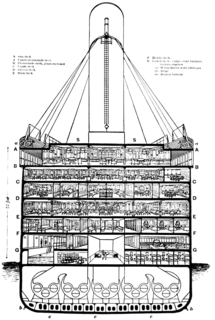
Reflecting the White Star Line's reputation for superior comfort and luxury, the RMS Titanic had extensive facilities for first-class passengers which were widely regarded as the finest of her time. In contrast to her French and German competitors, whose interiors were extravagantly decorated and heavily adorned, the Titanic emphasized comfort and subdued elegance more in the style of a British country manor or luxury hotel. Titanic's enormous size enabled her to feature unusually large rooms, all equipped with the latest technologies for comfort, hygiene, and convenience. Staterooms and public spaces recreated historic styles with a painstaking attention to detail and accuracy. There was a wide range of recreational and sporting facilities in addition which provided ample opportunity for amusement during a voyage.

























